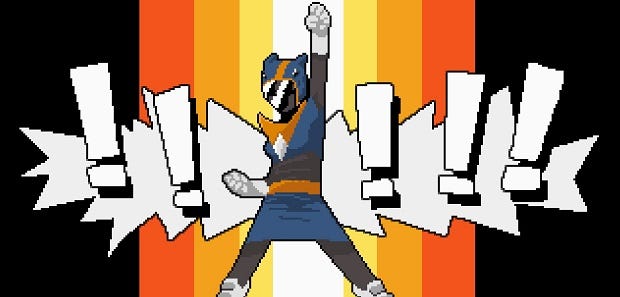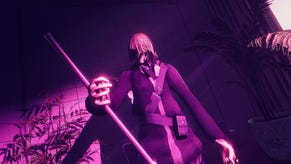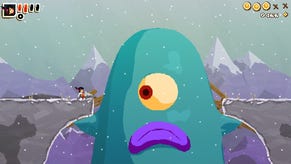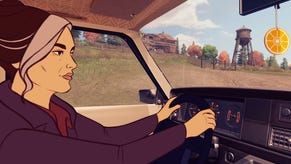Wot I Think: Chroma Squad
Super Saiyan Turn-based Actyan!
Children are fickle creatures, and today's craze is tomorrow's landfill. One of my earliest memories is of mum trying to convince me that He-Man was much cooler than the Teenage Mutant Ninja Turtles and, despite there only being one of him, that he could easily take them in a fight. I stubbornly refused to accept this reasoning, my painstakingly-accumulated He-Man collection was on the scrapheap, and the poor parents had to start buying TMNT toys instead.
Now that the children of the 80s and 90s are adults, something funny but predictable has happened. Everything old is new again, reborn or rebooted to try and bring our inner child back – and so we come to Chroma Squad [official site], the greatest Power Rangers game there never was.
The Power Rangers inspiration is obvious even before you read the title screen's tribute, but Chroma Squad is a much smarter take than what you might expect from a straight-up Power Rangers game. Rather than a game of the TV show, it's a game about making a TV show – following the eponymous Chroma Squad from their first days trying to set up their own independent production, through subsequent seasons and eventually, of course, a 'real' threat.
This is a great idea because, as we all know, the Power Rangers looked kind of awesome but the shows themselves were a badly-dubbed laughing stock held together with duct tape and nylon. By taking this route, Chroma Squad can have a bit of a laugh about Engrish and crappy costumes without doing that awful thing of 'hey this is bad but we know it's bad!' In fact it becomes part of the charm: you craft new costumes from bits of tape and glass, often have a quick chat with the actor playing the villain before episodes begin, and build up your audience to buy better studio equipment along the way.
This upgrade system is one of Chroma Squad's best qualities, with one fairly big caveat: on normal mode the game in general doesn't put up much of a fight, and your wallet overfloweth. In the first season money and materials are relatively tight, but once you start bringing in the cash and investing it you'll never look back. It's not so much that you can buy everything at once, but rather you never really have to save up for anything. The lump sum awarded at the start of every new season becomes overkill, and the next level of gear or facilities is taken for granted rather than worked towards.
With that said the system keeps your interest through the blindingly simple tactic of making the items and upgrades an interesting range of choices. What each of your five heroes is wearing can affect different stats, with the dichotomy often being skill regeneration against health, and a separate skill tree benefits from judicious gear-crossover. The crafting element, though simple, holds up better than the cash-dependent side because materials are slightly more limited, abilities are randomised, and constructing and configuring your giant mech becomes an enjoyable if undemanding diversion.
Of course there's a giant mech. Didn't you ever see Power Rangers? Once the studio-management is out of the way you hop into recording each episode, and, after some team dialogue, start biffing and powing the bad guys. Chroma Squad's core is isometric turn-based strategy, with you controlling the five heroes – who begin each episode in their civilian togs before you 'Chromatise' into their suits and unlock special abilities.
Each member of the team has a particular role: yellow scouts, shivs and stuns; pink heals and shoots arrows; blue has various shooty options; black is an up-close-and-personal slugger; red is the leader and can make the team form up around him and buff them. In addition to this, each member has a standard attack, with multiple lovingly-animated blows, and can end their turn by initiating 'teamwork' – which enables ganging-up on enemies and giving an acrobatic boost to teammates.
All of these abilities work together beautifully, and even build up a kind of superhero rhythm across the battle. At first it's team strikes and sneak attacks, picking off the stray enemies with special moves and exchanging buffs. By the time you're one-on-one with the boss and have whittled them down, it's more like this: you'll pull the team together with the leader, then use his Eagle Lasso to reel in the boss, quickly sync up around him with four teamworks, and bam. That's a wrap.
This kind of synergy - helped enormously by the beautiful animations, period-perfect pixel art and a few amazing chiptunes - almost papers over Chroma Squad's problems. The first is that there just aren't many environments – you'll get very familiar with them all by the end. Unfortunately Chroma Squad also falls into the previously-dodged trap of poking fun at this in later seasons. It's bad enough you're noticing the environmental repetition, without the game basically saying 'yep I know lol.'
A far more serious issue, however, is the ease of progress. Chroma Squad's tactical sections are fun to play, but don't have much bite. I began the game on Interesting (normal) difficulty, and quickly moved this up to Challenging (hardest available) after racing through the first couple of seasons without a scratch. Things barely improved: in four subsequent seasons I had team members downed a few times, but didn't fail a single mission.
I'm no tactical god, and expect that a decent turn-based strategy game on its hardest difficulty should be able to offer up a few problems. It's not that you want something punitive so much as you want to feel like learning the system is worthwhile – for all the fancy flips and flourishes, it begins to feel like Chroma Squad's core combat is powderpuff.
Part of the problem is the lack of variance in enemy types. Almost every stage has a bespoke boss monster, but the standard goons only have a few varieties – melee thug, gunner, healer, slightly tougher thug, assassin – and over the seasons this begins to really pall, particularly because later enemies are often just retextured lower-level enemies. Obviously the foot soldiers are never going to be the main attraction in a superhero show, but in a strategy game they're absolutely critical: the bread-and-butter enemies should be capable of both surprising and defeating careless and complacent players.
There's no risk of that in Chroma Squad. On normal difficulty the enemies spread out their attacks against your team and never threaten to focus on a specific member. On hard it's exactly the same – the higher damage values are the only reason you have the occasional KO. In a masterpiece of singleplayer turn-based design like Fire Emblem (I know it's not PC but run with me) the basic enemy troops don't have spectacular abilities, but are ruthless at taking down exposed or weakened units – which is why they're always a threat, and interesting to fight against. In Chroma Squad they feel like fodder.
This goes for the mech battles as well, unfortunately, which share the problem of being percentage-based punchouts – your mech and the enemy take turns to throw blows at each other, with yours having increased damage for each hit in the combo but a lesser chance to score the next blow. There is a layer of strategy in how you build your mech's abilities to fight strategically, but these fights look amazing and feel overused if anything. With a slightly reduced frequency these simple sections would be a refreshing break from the core action, but as it is the repetition makes them pall.
Which all means Chroma Squad is a bit like candyfloss – awfully sweet, and nice to eat, but ultimately insubstantial. That doesn't make it a bad game, and how Chroma Squad was made explains why. This exists because the developers kickstarted a Power Rangers-inspired strategy game, got funded, and you have to say they delivered exactly what the backers wanted: as a fan of turn-based tactics I have reservations, but as a super sentai fan's dream game it's brilliant. Crammed with in-jokes, cool costumes and giant mech customisation options, it's the best Power Rangers game we never got. And that is surely the point.
One major aspect of this charm within the game itself, which seems so small, is the ability to customise the name of your team, their 'Chromatise' motto, the name of your mech, and the finishing move. Thus my team is known as SAMURAI SMASH, they ride in THE STANTONATOR, and upon transforming pay tribute to Glasgow Celtic's European Cup Triumph by shouting 1967 STYLE! My inner child hits peak joy when the team finishes off an enemy with a tribute to the one and only Bret 'the Hitman' Hart: THE SHARPSHOOTER.
That kind of glee, though ephemeral, is why we bother with nostalgia at all. It's an easy thing to say but it's a hard thing to catch in a game, and Chroma Squad succeeds. Without the license it is free to evoke a minor era in children's television, rather than slavishly following branding precepts, and its approach feels fresher than a hundred reboots of old properties. As a game it is no kind of competition to a contemporary like Invisible, Inc. Everyone already knows, however, whether they're interested in this for other reasons. Chroma Squad is a decent game but, far more importantly, it is a little time capsule, a big tribute, and a perfect period piece for big kids.
Chroma Squad is available now.















